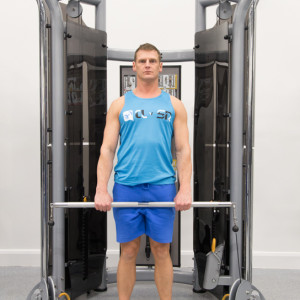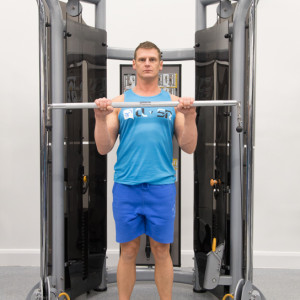Cable Reverse Curl
Starting position:
- Grasp the bar with a closed, pronated grip (palms facing the front of your thighs).
- Extend elbows, resting the bar attachment on the front of the thighs.
- Grip should be shoulder-width apart.
- Stand straight with feet shoulder width apart, keeping a slight bend in the knees.
- Keep upper arms tucked against torso and perpendicular to the floor.
Upward movement/concentric phase:
- Flex the elbows until the bar is 4 to 6 inches away from the front of shoulder(s).
- Keep standing straight with upper arms tucked against side of torso.
- Keep wrists straight during the lift.
Downward movement/eccentric phase:
- In a controlled fashion, allow the elbows to extend back to the starting position.
- Keep standing straight, only the elbow joint is to be moving as it extends.
Exercise Data
FAQ'S & FACTS ABOUT Cable Reverse Curl
What Is A Biceps Cable Reverse Curl?
A reverse cable curl is a resistance exercise, a variation of the biceps curl. The brachialis and brachioradialis are activated with pronation of the forearm. The pronation of the forearm also activates wrist extensors as stabilizers. This exercise is performed with a low pulley cable and straight bar attachment. Performing curls with cable tension provides constant resistance throughout the entire range of motion.
The concentric portion of the lift is elbow flexion, which involves the lifting of the weight. The eccentric portion is elbow extension, which involves the descent of the weight.
The purpose of the reverse cable curl is to strengthen the biceps from a different angle while emphasizing the activation of the brachialis, brachioradialis and forearm extensors. Reverse cable curls also promote the hypertrophy (increases in size) of the elbow flexors and forearm extensors.
Why Do Biceps Cable Reverse Curls?
Reverse cable curls strengthen and increase the size of the brachialis, brachioradialis and forearm extensors. Incorporating reverse cable curls in a training regimen complements bicep and forearm training. Although it is primarily an exercise for aesthetics, reverse cable curls also serve as an auxiliary exercise that can increase strength involved in other multi-joint exercises.
Anatomy Of A Biceps Cable Reverse Curl
The brachialis lies underneath the biceps brachii, originating at the front of the lower end of the humerus bone. Its insertion is located at the coronoid process of the ulna at the elbow joint. The brachialis is a primary elbow flexor. Upon pronation of the forearm, the biceps brachii (a forearm supinator) is deactivated, activating the brachialis to a greater extent during elbow flexion.
The brachioradialis is a superficial muscle of the lateral forearm. Its origin is located at the lateral supracondylar ridge of the lower end of the humerus bone. It inserts at the base of the styloid process of the radius (where the forearm meets the wrist). The brachioradialis is activated during elbow flexion upon pronation of the forearm, yet is most activated when semipronated as with a hammer curl.
The biceps brachii is located on the front of the arm, originating at the shoulder and inserting in the elbow joint. It consists of two heads, the long head (outer portion) and the short head (inner portion). The long head tendon helps stabilize the shoulder joint and its origin is located at the tubercle and lip of the glenoid cavity of the scapula (shoulder blade). The short head origin is located at the coracoid process of the scapula. The long and short head unite as the muscle bellies run down the front of the arm. Both heads merge, sharing insertion into the radial tuberosity of the elbow joint.
The biceps brachii flexes the elbow joint and supinates the forearm, therefore, its contribution is minimized upon pronation of the forearms.
Forearm pronation and maintenance of straight wrists during elbow flexion activates forearm extensors to act as stabilizers. Similar to the brachioradialis, the extensor carpi radialis longus originates at the supracondylar ridge of the humerus bone. Its insertion is located at the base of the second metacarpal at the wrist. The extensor carpi radialis brevis originates at the lateral epicondyle of the humerus, near the elbow. Its insertion is located at the base of the third metacarpal of the wrist. The extensor carpi ulnaris shares a relatively similar insertion and origin, extending from the elbow joint (lateral epicondyle of the humerus and posterior border of ulna) to the wrist (base of the fifth metacarpal).
The subscapularis works in conjunction with the other three rotator cuff muscles to stabilize the shoulder joint during standing bicep curl variations.
Variations Of A Biceps Cable Reverse Curl
Wide grip, narrow grip, using an EZ bar attachment.
How To Improve Your Biceps Cable Reverse Curl
Performing a narrower grip (index fingers approximately 4-6 inches apart) with your reverse cable curl may grant more of advantage. You can also vary the reverse grip by switching to an EZ bar attachment.
Strategically varying your reverse curls to target different angles and grips can result in optimal muscle activation that increases strength and hypertrophy of the biceps and forearm extensors.
It’s important to note that your repetition and set volume will depend on your goals (e.g. strength, hypertrophy, muscular endurance). It is also important to allow adequate recovery days in between biceps training to allow muscles to repair.
Common Mistakes When Doing Biceps Cable Reverse Curls
Extending the wrists during elbow flexion. The wrists are to remain straight throughout the full range of motion.
It is very common to observe an individual swinging their torso in efforts of lifting the weight with more ease. This compromises proper technique and biceps contraction. The reverse curl is a single-joint movement. The single-joint involved is the elbow joint. If you find yourself depending on momentum from swinging your torso to lift the weight, you may want to decrease the weight to prevent injury.
Standing on an unstable surface or with an unstable stance can also compromise technique. Your feet are your foundation and should be in a position of stability. If you are looking to maximize the contraction of your biceps, ensure that your feet are shoulder width apart, directly underneath your body, with a slight bend in the knees. Stand on a flat surface. Standing with one foot in front of the other during a reverse curl can also compromise balance and decrease the potential for optimal muscle contraction.
Injuries Or Ailments & Their Effects Regarding Biceps Cable Reverse Curls
If proper technique is not adhered to (e.g. swinging of the torso, dropping the weight quickly instead of controlling the descent on the eccentric portion of the lift), the likelihood of back, wrist and/or biceps injury increases.
Although rare, biceps tendon rupture may occur if warm-up is not sufficient and/or if intensity (load) is increased inappropriately.
If proper recovery is not implemented between training days for optimal muscle repair of the biceps, the biceps tendon becomes inflamed. Without proper rest and treatment, the inflammation remains and results in biceps tendonitis.
Impingement syndrome and rotator cuff injuries, in general, are commonly associated with biceps tendonitis/biceps tendinosis. Therefore, it’s best to avoid bicep exercises when addressing impingement syndrome/rotator cuff injury unless advised by a physical therapist.





